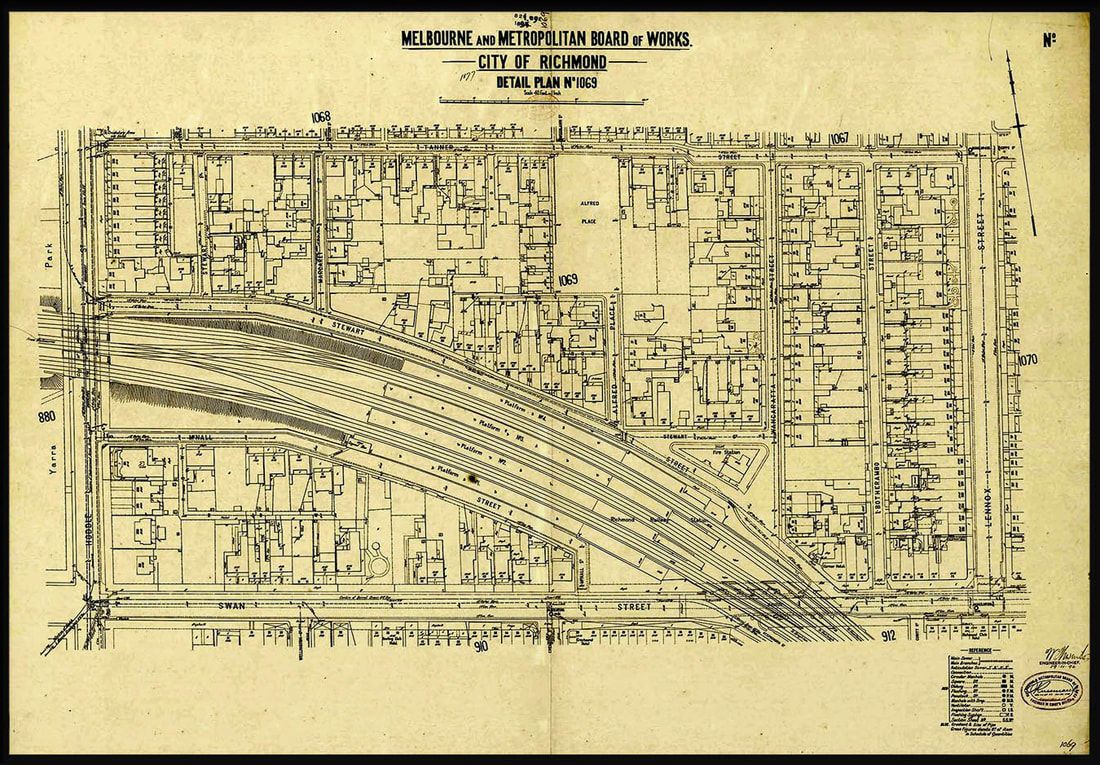28 Tanner Street Richmond is an historic building.
In the map below from 1896 there was no building here, and the block was called Alfred Place. We believe it was constructed around 1912. The building was developed in 2000 into 44 apartment shells, each owner being given the opportunity to design and develop their individual apartment. This individuality adds to the uniqueness of this development. In view of the history and heritage of this building, it requires the utmost care and attention. It is a valuable landmark and residents are privileged to own/and or reside in this Melbourne icon.
Strict guidelines come with the heritage overlay. The building façade (including windows) cannot be added to/altered without, firstly, consent from the Owner’s Corporation and second, consent from the Yarra City Council.
Council Heritage overlay documents state:
In the early 20th century the expansion of manufacturing across the nation was reflected in new industrial centres that were developed close to rail and road transport, as distinct from the Victorian-era industrial development that had occupied coastal sites or river and creek banks. Near to the transport hub of City of Yarra (Review of Heritage Overlay Areas 2007 HO332 Richmond Hill Heritage Overlay Area) Richmond Railway Station and busy Punt Road, grew a distinctive group of factories and warehouses, mainly associated with the growth of the clothing manufacturing industry in the City and dating substantially from the early decades of the 20th century. This area had previously been residential105. The Australian Knitting Mills Ltd. (41-43 Stewart St, knitted goods manufacturers) complex was at the centre of the Stewart-Tanner Streets industrial area development area. It was developed from 1912 when the supply for World War One uniforms was an impetus for its expansion and had another major building addition in 1922.
The signs are also of historic value:
As an example of use of raised cement ornamental parapet signs to promote the presence of industries in their locale, a past practise, made virtually obsolete by the Second World War and typically replaced today by illuminated signs. The Rosella complex makes a key contribution to Richmond’s collection of significant industrial signs which includes signs at Bryant & May, AKM, Kayser and Pelaco.
In the map below from 1896 there was no building here, and the block was called Alfred Place. We believe it was constructed around 1912. The building was developed in 2000 into 44 apartment shells, each owner being given the opportunity to design and develop their individual apartment. This individuality adds to the uniqueness of this development. In view of the history and heritage of this building, it requires the utmost care and attention. It is a valuable landmark and residents are privileged to own/and or reside in this Melbourne icon.
Strict guidelines come with the heritage overlay. The building façade (including windows) cannot be added to/altered without, firstly, consent from the Owner’s Corporation and second, consent from the Yarra City Council.
Council Heritage overlay documents state:
In the early 20th century the expansion of manufacturing across the nation was reflected in new industrial centres that were developed close to rail and road transport, as distinct from the Victorian-era industrial development that had occupied coastal sites or river and creek banks. Near to the transport hub of City of Yarra (Review of Heritage Overlay Areas 2007 HO332 Richmond Hill Heritage Overlay Area) Richmond Railway Station and busy Punt Road, grew a distinctive group of factories and warehouses, mainly associated with the growth of the clothing manufacturing industry in the City and dating substantially from the early decades of the 20th century. This area had previously been residential105. The Australian Knitting Mills Ltd. (41-43 Stewart St, knitted goods manufacturers) complex was at the centre of the Stewart-Tanner Streets industrial area development area. It was developed from 1912 when the supply for World War One uniforms was an impetus for its expansion and had another major building addition in 1922.
The signs are also of historic value:
As an example of use of raised cement ornamental parapet signs to promote the presence of industries in their locale, a past practise, made virtually obsolete by the Second World War and typically replaced today by illuminated signs. The Rosella complex makes a key contribution to Richmond’s collection of significant industrial signs which includes signs at Bryant & May, AKM, Kayser and Pelaco.


